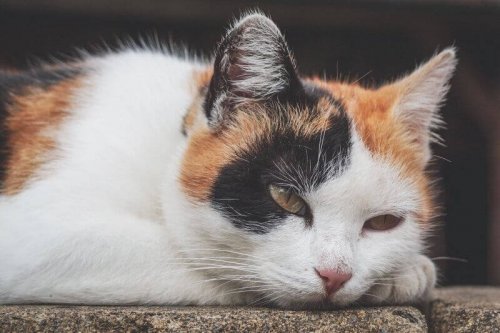Anemia in Cats: Symptoms, Causes and Treatment

Anemia in cats is as common as it is in humans. The condition is due to a decrease in the number of erythrocytes (red blood cells) in the blood. These are the cells responsible for transporting oxygen to body tissue.
In addition, anemia also lowers hemoglobin count. This is the pigment in red blood cells, its function is to trap oxygen molecules and carbon dioxide.
There are many causes of anemia in cats and each one requires specific treatment. Today we’d like to tell you how to detect and treat it. Do keep in mind that any suspicions should be run by your veterinarian, and they’ll make an accurate diagnosis and indicate the best course of action.
How do you detect anemia?
In general, the clinical symptoms of anemia are tiredness, depression, decreased appetite, and pale mucous membranes. There may also be weight loss in some cats. In addition, some animals suffer from respiratory anomalies, the same symptoms that other conditions have. As you’re about to learn, the cause will determine the outcome of the anemic cat.
A blood test from your veterinarian can confirm a case of anemia. They specifically look at the blood count. That is how many blood cells – red, white, and platelets – are present in the cat’s blood sample and their ratio. They also look at the hemoglobin count.
If the red blood cell values are below the minimum threshold established for cats, this means the cat is anemic. However, the blood count only confirms a case of anemia, but not its cause.

Causes of anemia in cats
Depending on the cause or how their organism responds, there are many different ways to classify the types of anemia in cats. For example, depending on whether the bone marrow can reproduce new red blood cells or not, then anemia would fall into one of the following classes:
- Regenerative anemia: this means the animal is losing more red blood cells than their bone marrow can generate.
- Non-regenerative anemia: the bone marrow has stopped producing red blood cells and so there aren’t any new ones. This type of anemia is more serious and its prognosis isn’t good at all. It usually means there’s a more serious condition related to the kidneys, endocrine system, and/or some kind of immune disease. The bacteria of the genus Ehrlichia or Hemobartonella can also lead to anemia.
There are other classifications, but these are the most common.
Treatment of anemia in cats
Treatment will depend on the underlying cause, as per a veterinarian diagnosis. However, if your cat is facing a severe case of anemia, then they may need a blood transfusion to keep them stable.
Transfusions provide an immediate supply of red blood cells. As with a human transfusion, the donor’s blood must be compatible with that of the patient.
If the anemia is due to a lack of nutrients, then all you need to do is evaluate and improve the cat’s diet. Your veterinarian will help you design one that’s appropriate for your particular case.
Is anemia preventable?
It would be difficult to prevent. Especially if your pet already has a disease that affects the production of their red blood cells and you don’t notice any symptoms. It’s for this reason that you should take them to the vet twice a year for regular checkups.
The good news is you can definitely control certain things to maintain your cat’s good health. These include:
- Providing a healthy, balanced and complete diet. Most processed cat food is not recommended, so you have to read the labels for ingredients and nutritional value. Remember, higher cost doesn’t equal quality.
- De-worming your cat every month in order to prevent external parasites; every three months for internal parasites. It’s very important that you use antiparasitic drugs specifically formulated for cats. (Anti-parasitic treatments for dogs contain substances that are highly toxic to cats.)
- Vaccinating your cat against infectious diseases. For example, leukemia and feline AIDS (Feline Immunodeficiency Virus) could lead to anemia. There are vaccines out there for both conditions. So, be careful exposing your cat to other animals if they’re not yet vaccinated.
Now you know how anemia could be a symptom of other more serious conditions. Don’t hesitate to consult your veterinarian if you notice unusual symptoms as you should know the cause in order to treat it.
Once your veterinarian confirms a diagnosis, you can begin treatment. You can prevent anemia in your cat by feeding them a proper diet, protecting them against parasites and vaccinating them in a timely manner.
All cited sources were thoroughly reviewed by our team to ensure their quality, reliability, currency, and validity. The bibliography of this article was considered reliable and of academic or scientific accuracy.
- Fidalgo LE, Rejas J, Ruiz de Lopegui R, Ramos JJ. Patología Médica Veterinaria. Enfermedades eritrocitarias. Ed. Universidad de León, Universidad de Santiago y Universidad de Zaragoza; 2003. P. 163-168.
- Anemia por hemoplasmas felinos. Avepa.org, 2019.
- Transfusiones de sangre. Avepa.org, 2019.
- Alteraciones de la serie roja y de las plaquetas. PortalVeterinaria, 2019.
- Anemia hemolítica inmunomediada primaria en un gato. PortalVeterinaria, 2019.